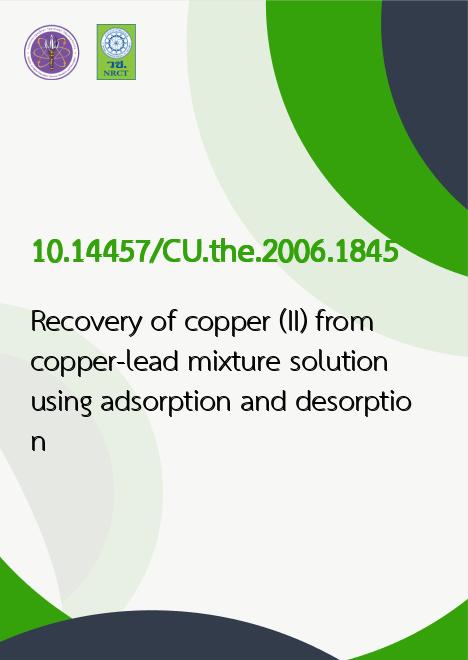
|
Recovery of copper (II) from copper-lead mixture solution using adsorption and desorption |
|---|---|
| รหัสดีโอไอ | |
| Title | Recovery of copper (II) from copper-lead mixture solution using adsorption and desorption |
| Creator | Apipreeya Kongsuwan |
| Contributor | Prasert Pavasant |
| Publisher | Chulalongkorn University |
| Publication Year | 2549 |
| Keyword | Sewage -- Purification -- Heavy metals removal, Adsorption, Copper, Carbon, Activated |
| Abstract | Eucalyptus bark was used to produce activated carbon through the phosphoric acid activation process. This activated carbon was then used for the adsorption of copper and lead ions. The results indicated that the optimal pH for adsorption was 5 and the rate of adsorption could be predicted with the pseudo second order model. The maximum adsorption capacities for Cu(II) and Pb (II) were 0.45 and 0.53 mmol g [superscript -1] Carboxylic, amine and amide groups were found to involve in the adsorptions of Cu(II) and Pb (II). Ion exchange should not be a major mechanism for the uptakes of both heavy metals and the actual mechanism should simply be physical adsorption. For binary components adsorptions, activated carbon could adsorb more Pb (II) than Cu(II) where the presence of the secondary metal ions suppressed the adsorption of the primary metal ions. However, Pb (II) was found to have stronger negative effect on the adsorption of Cu(II) than vice versa. Citric acid was used to desorb Cu(II) and Pb (II) from the loaded activated carbon. The results showed that increasing desorbing agent concentration and desorption temperature increased desorption efficiency. For single component systems, the desorption best took place at the citric acid concentration of 1 mol L[superscript -1] whereas the solid/liquid (S/L)ratio of either 4 or 8 was found to give satisfactority desorption results. For the binary systems, citric acid concentration of 0.01 mol L [superscript -1] and the solid/liquid (S/L) ratio of 16 were found to be suitable conditions for the separation of both metal ions. The rate of desorption could be predicted with the pseudo second order model. |
| URL Website | cuir.car.chula.ac.th |